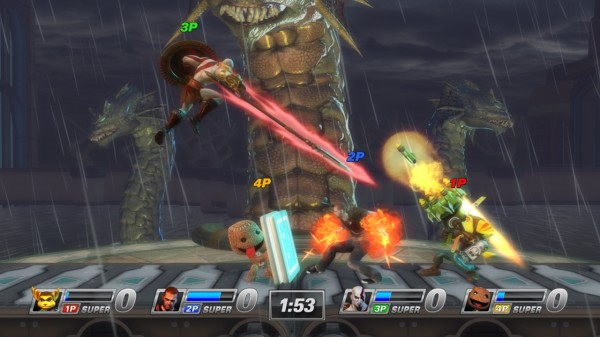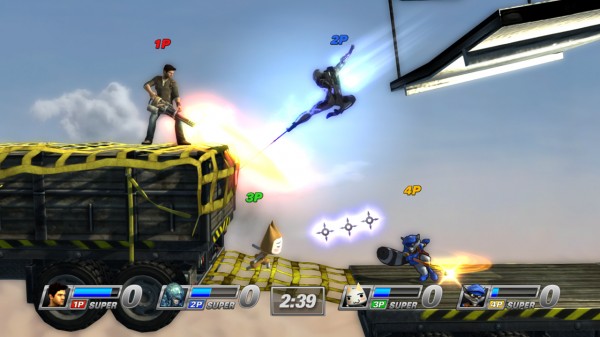
PlayStation All-Stars Battle Royale PS3 Review
From its first announcement, PlayStation All-Stars Battle Royale was always going to have an uphill struggle against the waves of gamers calling it out as a Super Smash Bros. clone. Even the official PlayStation YouTube channel had put the words “Super Smash Brothers” in its tags, which I guess would mean Sony’s PR team just assumed it was a replica of Nintendo’s smash-hit fighter. The industry is full of copycat games, so I am fine with Sony trying their own take on the formula, but with some strange design choices and missing characters from Sony’s earlier – and just as important – years of gaming, PlayStation All-Stars Battle Royale isn’t as all-star as you would think.
After the stylish video intro, the first impressions of All-Stars Battle Royale end up getting tarnished by some bad presentation. This is because as soon as the title hits, the game greets you with a disgusting and plain menu design that looks like something that has come from a prototype demo, rather than a polished, Sony-developed title. I don’t know why the menu designers made it look so amateurish, but time certainly could have been used to make the menu interface more professional looking and intuitive to access sections. Why do I need to go from the Main Menu into a customise screen and then select a character to be able to change their costume? You should be able to do that from the character select screen. This is by far the worst part of All-Stars Battle Royale, so I might as well get it out of the way first.

The character roster is also going to get some questions thrown at it. This is PlayStation All-Stars, so you would expect key characters that were exclusive to Sony platforms or made their name on a PlayStation system. This is not the case, as there are some huge characters missing that really should be here. Where is Crash Bandicoot? Lara Croft? Spyro? A Final Fantasy character? A Ridge Racer car? OK, that last one is just me being silly, but for whatever reason, some big hitters are not here. I am guessing it is a license issue (I hope it is), and if that is so, then that really sucks that Sony could not get those heroes to be in the game.
That does not mean I am saying there isn’t a decent amount of worthwhile PlayStation heroes – there is, as the game includes the likes of Sackboy, Ratchet and Clank, Jak and Daxter, Kratos and PaRappa. The problem lies with the fact you can tell that the developers were struggling to find enough stars to feature in the game (Fat Princess?), which means you end up with characters like Big Daddy from Bioshock (a PlayStation All-Star? Really?) filling up the roster of 20 heroes.

There is no denying that All-Star Battle Royale captures the essences of the games in its 14 stages. Each stage normally blends two games together, such as the Hades level taken from God of War that breaks into Patapon when the little guys invade from the background and start shooting arrows at Hades in line with the beat of the music, which so happens to stop him from smashing his claw weapons at you. Sure it’s a little weird having such distinct art styles appear together, but it makes for some great and entertaining level designs. Other levels include LittleBigPlanet and Buzz (where you can answer the questions by moving to the correct platform the answer hovers over), Uncharted 3 with its plane section blending with Bioshock Infinite, and last but not least, the Chop Chop Master Onion’s Dojo that blends with Killzone 3. Seeing the stages unfold and interacting with them are the highlights of the game, and it is one thing All-Stars Battle Royale does better than Super Smash Bros..
Rather than directly ripping off the gameplay of Super Smash Bros., the developers, SuperBot Entertainment, have tried to make All-Stars Battle Royale a more technical fighting game. One big difference is that there is no health system in play for the characters. This is because players can only die from super attacks. Normal attacks, which are done with Square, Triangle and Circle, and can also be changed by pressing a direction on the stick (just like Super Smash Bros., and each character has moves key to their game’s play style), adding points to your super metre when you successfully hit an opponent. If you manage to hit a combo then you will gain metre points faster.

Super attacks instantly kill an opponent when successfully connecting them, but there is certain skill behind activation due to there being three levels of strength. The first level is fairly weak, is risky to use and normally kills one person. Two adds a bigger area and makes it easier to kill people in a line. Level three, on the other hand, shows your character powering up in a quick cutscene. They become a killing machine as each hero is given a ridiculous power that makes it tremendously easy to destroy everyone. For example, Nathan Drake’s level three attack turns everyone into the monsters from the first Uncharted game. Once activated, Drake must shoot players with his pistol as they walk around as the transformed beasts. Getting to level three takes time, so there is strategy in when you use your metre. Do you try and get level three where you are near-enough guaranteed three kills, or do you keep reusing level ones, but at the chance of completely missing a kill?
At first it takes a while to adjust to this style of gameplay. It is unusual to not see health bars or not be dealing damage for most of the game, but it does work and it is satisfying and fun when you manage to pull off a well-earned kill. Another weird thing is that the normal free-for-all battles do not allow you to see how many kills you have, so you have no idea who is winning. The only thing on display is the timer, the characters and their super metres. I found that to be annoying as I would forget during a hectic battle how many points I had. A person is awarded two points for a kill and is reduced a point if killed. If you are good at keeping the count in your head, then you will probably adapt fine, but for me it made me go all-out to build metre as fast as possible and dodge away from players with super metre. Maybe that was the idea behind this design choice, so that people would not play the keep-away game when they knew they were in front.

Arcade Mode sets the story by giving each character a background plot to why they are here. Most of it is nonsense, but Arcade Mode does well to show players the different game modes on offer. Apart from free-for-all, you also get one-on-one, first to three, and two vs. two, and each match can either be based on a time limit or stock of lives. All-Stars Battle Royale does exceptionally well with the tutorials, going deep into the mechanics to cover topics like how items work, such as the spinning axe or the grenade that stops people using super attacks, to having specific character challenges that get tougher as you progress through them. These training and challenge options are modes you would find in serious fighting games. It is welcoming to see the game demonstrating to the player just what is possible in its mechanics.
Multiplayer is what the game is all about and you can play All-Stars Battle Royale with up to four players locally. Online allows you to take one friend with you on the same console into online matches, which is neat when you set up two vs. two and your buddy is right next to you as you lay the smack down on random people. There are two modes of play when going online, ranked matches and custom matches. Ranked matches are free-for-all fights with random players. The rank match has seasons, which seem to take place over a month, and the ladders are reset once the month is up. You need to keep playing if you want to find yourself at the top of the leaderboards, as even now, there are some hardcore players with a ridiculous amount of wins and matches played. Custom allows you to set up specific game types from the adequate amount options available, such as time, stock of lives, level interaction and what items can be used. Overall, the online experience is really good. The net code seems to be great, as I did not run into lag from the four hours I spent playing online.

If you are also a Vita owner then you will be happy to know that buying the PS3 version of the game allows you to then download a Vita version for free. It seems the data is pulled from the Internet, as loading the game on the Vita and connecting online unlocked all the bonus items and profile logos I had unlocked in the PS3 version. You can also play against PS3 players locally and online. This is a brilliant feature and I hope Sony stick with the idea because it offers so much value for money and goes to show that the company is listening to requests from their fanbase. An amusing thing about the Vita version is that the menu system is actually better than what is on the PS3 version. The game itself runs very well and looks great on the handheld. No shortcuts were taken to bring the game to the Vita.
Seth Killian (you might remember this brilliant guy who left Capcom to work at Sony) stated that he wanted PlayStation All-Stars: Battle Royale to be a viable competitive fighting game that anyone could get into. It’s certainly very accessible, but I find it hard to see the game being looked at as a serious fighter, as it feels too random. Sure you can do one-on-one matches, and people are providing videos of flashy and fancy combos, but that still does not make it a game that I feel captures the sense of a proper competitive and fair fighting game. Maybe I’ll be proven wrong soon. As it stands, PlayStation All-Stars: Battle Royale is a cool, if limited, way to celebrate the history of Sony’s time in the video game business. It is just a shame that some of the ideas that give the game its own identity spoil it. It’s neither as great as the game that influenced it, nor as designed well enough to be a competitive fighter. A respectable party fighter to have fun with your friends, then – not that there is anything wrong with that.
